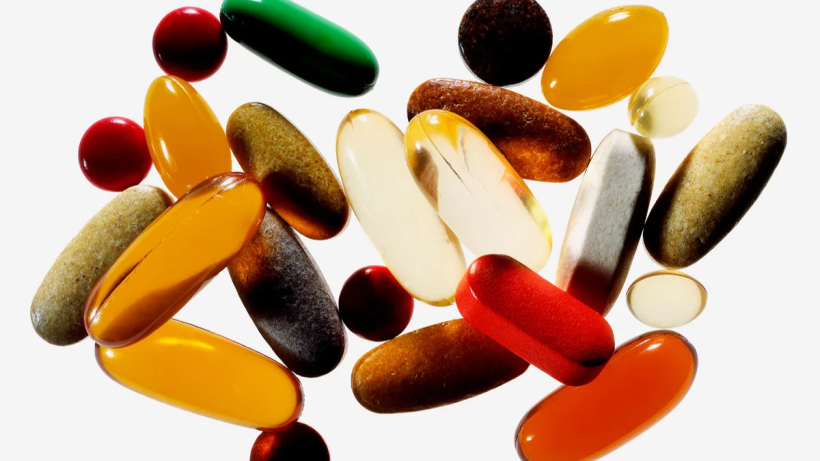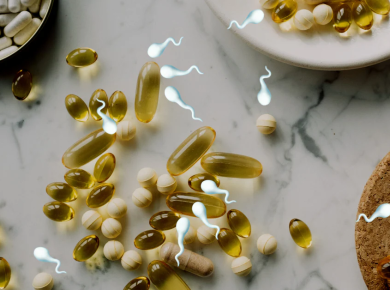Maximum levels of vitamins
A possible Overdose of vitamins has been a popular topic in non-scientific media for years. Unfortunately, the research is usually very poor, because the aim is to increase circulation by presenting a pseudo-sensation. The facts clearly indicate that we really only have to give intensive thought to the widespread undersupply.
We have therefore summarized the facts about the vitamin supply of a possible overdose in a condensed form. Read here:
- What do the NRV or RDA percentages shown on the packaging of food and dietary supplements actually mean?
- What if you take more than the NRV?
- What does the “upper level” mean?
WHAT DO THE NRV / RDA MEAN ON THE PACKS?
“NRV” is the abbreviation for “Nutritional Reference Value“. RDA is the abbreviation for “Recommended Daily Allowance“. RDA means the same statutory value as NRV, just under a different name. While the reference value RDA used to be named in the EU, it is now law in the EU to designate it as NRV. There are statutory NRV standard amounts for all vitamins and for many trace elements as well as magnesium and calcium.In the USA and outside the EU these values are still usually referred to as RDA.
Definition NRV: The amount ofNutritional Reference Value NRV specifies the amount of daily intake of a micronutrient at which a healthy young person who does not smoke, does not drink alcohol and does not take any medication does not show any measurable deficiency symptoms.
As you can immediately see from the definition, the NRV value is on minimum value for a certain very healthy population. In special situations such as pregnancy, old age, digestive problems, illness and medication, the daily requirements can sometimes increase significantly. The D.G.E. German Society for Nutrition e.V. for the population group from 40 years of age a vitamin D intake of 10 µg to 20 µg (200% – 400% NRV). Gynecologists generally recommend a daily intake of 400 µg to 800 µg folic acid (200% – 400% NRV) if pregnancy is possible.
Above all, the NRV are not an optimal value for vitamin supply. There is no statutory optimal amount of vitamins and trace elements. In nutritional medicine, optimal values are generally assumed to be well above the NRV.
TheIn particular, NRV are not maximum values for the daily intake of vitamins or trace elements. So if you’re taking three or even ten times the NRV of a vitamin, it can still be significantly less than the optimal or maximum amount.
WHAT ABOUT VITAMIN OVERDOSE? WHAT ARE THE MAXIMUM LEVELS OF VITAMINS?
You must often read in the newspaper that vitamin overdose is dangerous. Unfortunately, many editors don’t really deal with the matter and are just happy if they can captivate readers with a panic headline about an alleged vitamin overdose and sell their newspaper.
The fact is: the European food authority EFSA has only been able to set a recommended upper limit for long-term intake for some vitamins, minerals and trace elements. There are no upper limits set by the EFSA for seven vitamins because no side effects were found in any of the published studies, even with extreme dosages.
When determining maximum values, there are three types of values that are discussed:
- The lowest dose at which side effects of ingestion have been reported in a study (LOAEL: Lowest Observed Adverse Effect Level), or
- the highest dosage in all studies in which no side effects were reported (NOAEL – stands for “No Observed Adverse Effect Level“), or the
- Upper Level (UL) recommended maximum value set by law.
The Upper Level UL has been set by the EFSA for six of the thirteen vitamins and for some trace elements. This was based on the NOAEL, i.e. the highest amount for which no side effects were reported, and then a safety buffer of mostly 50% or more was deducted. This is done on a case-by-case basis, depending on what the side effects look like with significantly higher intake.
Critics argue that these values set by EFSA may be far too low. Because the consideration only includes the negative side effects of the intake, but not the positive effects of the high vitamin intake. If in a study with high vitamin intake, 50 people out of 100 had a health advantage, but five experienced side effects, the EFSA recommends a significantly lower intake as a precautionary measure.
A treating doctor can therefore have good reason to recommend vitamin intake above the upper limits or the NOEAL for a sick person. This can only be an individual recommendation based on a medical examination and diagnosis, but is not a general recommendation for taking it.
VITAMIN DEFICIENCY ACCORDING TO THE NATIONAL CONSUMPTION STUDY 2008
Do we really have to worry more about a possible overdose? Or shouldn’t we rather think about a healthy diet with enough fruit and vegetables to ensure only our minimum requirement of vitamins?
In a study of more than 20,000 people from Germany, the eating habits were analyzed in detail over a period of one year. The study (“National Consumption Study 2008”) was commissioned and paid for by the federal government. The results can therefore be regarded as very meaningful. The results were published in 2008. The “Results Report Part 2” of the National Consumption Study 2008 shows exactly how many people per population group (by gender and age group) less than the recommended minimum amount of NRV eat.
The results are frightening – and frighteningly little is known:
- About 80% – 90% of the population has a folic acid deficiency
- Iron deficiency in about 75% of women between the ages of 15 and 50
- Vitamin E deficiency in about 50% of the population
- Vitamin C deficiency in about 33% of the population
- Zinc deficiency is found in about 25% of the population.
- etc. etc.
A long-term undersupply of vitamins and trace elements results in various health restrictions. In the most harmless case, it is “only” hair loss, for example in iron deficiency orBiotinmangel occurs as a typical consequence.
folic acid deficiency in the first few weeks of pregnancy leads to a significantly increased risk of severe irreversible malformations (spina bifida, neural raw defect) in the child. In adults, a sufficiently high intake of folic acid as well as vitamin B12 and vitamin B6 is necessary to keep the homocysteine level in a healthy range. A lack of these vitamins can lead to increased homocysteine levels, which have similar negative effects on blood flow, heart and circulatory system as high cholesterol levels.
Also immune system, mood, sleep, energy, hormones and drive are directly dependent on an adequate intake of vitamins.
NRV AND MAXIMUM VALUES OF VITAMINS
NRV (minimum daily amounts as stated on the pack) and upper levels of vitamins according to the European Food Safety Authority EFSA are (as of 11/2021):
| micronutrient | NRV | UL Upper Level |
| Vitamin A (Retinol) | 800 µg | 3.000 µg |
| beta-carotene | n.v. | n.v. |
| Vitamin D (Cholecalciferol) | 5 µg | 100 µg |
| Vitamin E (Tocopherol) | 12 mg | 300 mg |
| Vitamin K K1: Phyllochinon K2: Menachinon K3: Menadion | 75 µg | n.v. |
| Vitamin B1 (Thiamin) | 1,1 mg | n.v. |
| Vitamin B2 (Riboflavin) | 1,4 mg | n.v. |
| Vitammin B3 (Niacin) | 16 mg | 900 mg nicotinamide or 10mg nicotinic acid |
| Vitamin B5 (pantothenic acid) | 6 mg | n.v. |
| Vitamin B6 (Pyridoxin) | 1,4 mg | 25 mg |
| Biotin (Vitamin B7) | 50 µg | n.v. |
| Folic Acid (Vitamin B9) | 200 µg | 1.000 µg |
| Vitamin B12 (Cobalamin) | 2,5 µg | n.v. |
| Vitamin C (ascorbic acid) | 80 mg | n.v. |
n.a.: not available, i.e. not specified by EFSA and not yet ascertainable. Source:https://www.efsa.europa.eu/sites/default/files/assets/UL_Summary_tables.pdf
NRV AND MAXIMUM LEVELS OF TRACE ELEMENTS AND MINERALS
NRV (minimum daily amounts as stated on the pack) and upper levels of minerals and trace elements according to the European Food Safety Authority EFSA are (as of 11/2016):
| micronutrient | NRV | UL Upper Level |
| Calcium | 800 mg | n.v. |
| Chloride | 800 mg | n.v. |
| Chrom | 40 µg | n.v. (WHO: 250 µg) |
| To demand | 12 mg | n.v. |
| fluoride | 3,5 mg | 7 mg |
| Iodine | 150 µg | 600 µg |
| Potassium | 2.000 mg | n.v. |
| copper | 1 mg | 5 mg |
| Magnesium | 375 mg | unclear (DE: 250 mg) |
| Eat | 2 mg | n.v. |
| molybdenum | 50 µg | 600 µg |
| Phosphor | 700 mg | n.v. |
| Selenium | 55 µg | 300 µg |
| Zink | 10 mg | 25 mg |
n.a.: not available, i.e. not specified by the EFSA and not yet ascertainable due to insufficient studies.
NRV AND MAXIMUM VALUES OF AMINO ACIDS
NRV (minimum daily amounts as stated on the pack) of amino acids has not been specified by the European Food Safety Authority for food labelling. Free amino acids are very safe food components. Of course, when we dose the free amino acids in our products, we take great care to ensure that the dosage contributes positively to the nutritional balance of these free amino acids. On the other hand, we dose all amino acids in the safe, non-toxic and non-pharmacological range.




